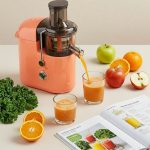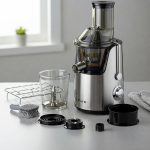Indroduction
A pure juicer is more than just a kitchen appliance—it’s a game-changer for anyone passionate about health and nutrition. With growing awareness of the benefits of fresh juice, investing in a high-quality juicer can help you extract maximum nutrients, flavors, and freshness from fruits and vegetables. But with so many options available, how do you choose the right one?
In this ultimate guide, we’ll explore everything you need to know about pure juicers, including their benefits, types, features, and maintenance tips to ensure you make the best choice for your kitchen.
What is a Pure Juicer?

A pure juicer is a high-quality juicing machine designed to extract the most juice while retaining essential nutrients, enzymes, and natural flavors. Unlike traditional centrifugal juicers that use high-speed spinning blades, pure juicers often use a cold-press or two-stage hydraulic press process to ensure minimal oxidation and maximum yield.
These juicers are perfect for those who prioritize nutrient retention and want fresh, high-quality juice without preservatives or artificial additives.
Benefits of Using a Pure Juicer
1. Maximum Nutrient Retention
Pure juicers use slow, cold-press extraction methods, which prevent heat buildup and oxidation. This process preserves vitamins, minerals, and live enzymes, making your juice healthier and more beneficial for your body.
2. Higher Juice Yield

Compared to traditional juicers, a pure juicer extracts more juice from the same amount of produce. This means you get more value from your fruits and vegetables, reducing waste and saving money in the long run.
3. Long-Lasting Freshness
Cold-pressed juice from a pure juicer can last up to 72 hours in the refrigerator without losing its nutritional value, unlike juices made from high-speed juicers, which degrade quickly.
4. Less Oxidation, Better Taste
Oxidation can make juice taste bitter or metallic. A pure juicer minimizes oxidation, resulting in fresh, naturally sweet, and flavorful juice.
5. Versatility in Juicing
Whether you’re juicing leafy greens, hard vegetables, citrus fruits, or even nuts for almond milk, a pure juicer can handle a wide range of ingredients efficiently.
Choosing the right pure juicer depends on your needs and preferences. Here are the main types available:

1. Cold-Press Juicers (Masticating Juicers)
• Operate at low speeds to crush and press produce
• Preserve nutrients and enzymes
• Ideal for leafy greens and fibrous vegetables
• Produces higher-quality juice with less foam
2. Hydraulic Press Juicers
• Use a two-stage process: grinding and pressing
• Extracts the highest amount of juice with minimal oxidation
• Best for juice enthusiasts who want professional-grade results
• Often more expensive but worth the investment
3. Twin Gear Juicers (Triturating Juicers)
• Feature two interlocking gears to crush and press produce
• Excellent for tough ingredients like wheatgrass and ginger
• Produces rich, flavorful juice with high nutrient content
• Requires more time for cleaning and maintenance

4. Centrifugal Juicers (Not Recommended for Pure Juicing)
• Use high-speed spinning blades
• Generates heat, leading to nutrient loss
• Juice oxidizes quickly and loses freshness
• Not ideal for those looking for high-quality juice
How to Choose the Best Pure Juicer
When selecting the best pure juicer, consider the following factors:
1. Juice Quality
Look for a juicer that produces pulp-free, smooth, and nutrient-dense juice. Cold-press and hydraulic press juicers are the best options.
2. Juicing Speed
While slow juicers take longer, they retain more nutrients and produce better juice quality. Avoid high-speed juicers if you want pure juice.
3. Ease of Cleaning
A juicer with removable, dishwasher-safe parts makes cleaning hassle-free. Some models also come with cleaning brushes for easy maintenance.
4. Noise Level
If you prefer a quieter juicing experience, choose a masticating or hydraulic juicer, as they operate at lower speeds with minimal noise.
5. Durability and Build Quality
A stainless steel or BPA-free plastic juicer ensures longevity and safe juice extraction. Check customer reviews to verify build quality before purchasing.
6. Price and Warranty
While high-end pure juicers may cost more, they often last longer and come with extended warranties. Consider it an investment in your health.
Benfits of pure green jucier

Green vegetables are very healthy, but at times it is not realized that the vegetables also carry anti-nutrients. For instance, oxalic acid is present in a few green vegetables, like spinach. Oxalic acid can be absorbed from diet and as it is toxic it needs to be eliminated from the body through the kidneys. In certain situations, oxalate can bind with calcium in the kidneys to form stones which can lead to compromised kidney function. This research seeks to compare two techniques of vegetable juice production using a high-speed blender or a masticating juicer. Oxalic acid content, calcium, pH and titratable acidity (TA) were analyzed in both juices. Total oxalic acid was determined using HPLC, calcium content was determined using a Coupled Plasma Optical Emission Spectrophotometer. Dry matter, pH and TA were determined based on AOAC procedures. The maximum total oxalate (OA) in juice produced through a masticating juicer was 7638.27 mg OA/100 g dry matter . The maximum calcium level was present in the fiber fraction or in the leftover juice through masticating juicer method, and that was 10.04 mg/100 g juice. However, the TA content of thick juice extracted through high speed blender was not remarkably different from the watery juice yielded by the masticating juicer. The smoothie-like inexperienced juice made the usage of a high-velocity blender changed into more healthy for the reason that soluble and insoluble oxalate extracted in the juice was less than in the clear juice made using a masticating juicer.
How to Maintain Your Pure Juicer
To extend the lifespan of your pure juicer, follow these simple maintenance tips:
1. Clean Immediately After Use
Juice residue can harden and become difficult to clean. Rinse and wash parts as soon as possible.
2. Use a Cleaning Brush
Most pure juicers come with a specialized brush for scrubbing small crevices. Use it to clean the mesh filter and pulp collector.
3. Avoid Overloading the Juicer
Feeding too many ingredients at once can clog the juicer. Feed produce slowly and in small portions.
4. Store Properly
Ensure all parts are dry before assembling or storing the juicer to prevent mold growth.
5. Descale Regularly
Mineral deposits can build up over time. Soak parts in a vinegar or citric acid solution once a month to remove any scale buildup.

Best Fruits and Vegetables for a Pure Juicer
Here are some of the best ingredients to use in your pure juicer for maximum nutrition:
Fruits Vegetables Leafy Greens Other Ingredients
Apples Carrots Spinach Ginger
Oranges Beets Kale Turmeric
Pineapples Celery Swiss Chard Almonds (for nut milk)
Berries Cucumbers Parsley Lemon
Conclusion
Investing in a pure juicer is one of the best decisions you can make for your health. It allows you to enjoy fresh, nutrient-packed juice while saving money and reducing waste. Whether you choose a cold-press, hydraulic press, or twin-gear juicer, you’ll benefit from better juice quality, higher yield, and superior taste.
By following proper maintenance practices and using high-quality ingredients, your pure juicer will continue to serve you for years to come. Ready to take your juicing experience to the next level? Choose the right pure juicer today and start enjoying the health benefits of fresh, homemade juice!

